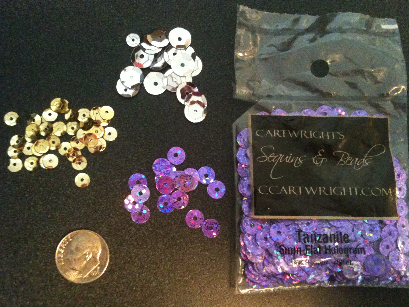The Materials
There are many styles of costumes out there, but believe it or not, their base materials are pretty much the same.
~"Button and Craft" Thread: Also known as "Button and Carpet" thread, you'll find this thread in a fabric store near the rest of the sewing threads. They typically come on smaller spools, and they'll be near the upholstery thread. The color selection is limited, with black and white being the most commonly found. It's very strong and will be what holds your costume together. I even use it for all beading and fringe and for any hand sewing for the construction of the costume. *Fun Fact - in previous generations, bellydancers used dental floss for these purposes. It's very strong, holds strands of beads securely, and it's minty fresh.
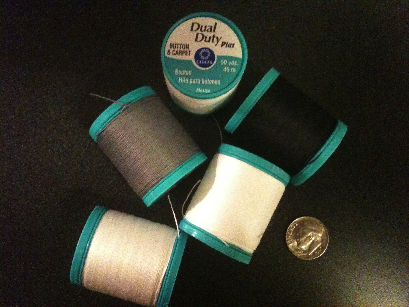
~Thread: Regular thread is used for sewing machines. I use cotton or cotton-poly blend threads. These come in a wide range of colors, and can be used for sewing together skirts, tops and pants, for adding darts in the interfacing belt base, and even for covering the belt base in decorative fabric.
~Grosgrain Ribbon: This is what bra straps are made of in quality costumes, and sometimes the edges of belts are lined with it as well.
~Interfacing: Super thick interfacing called "stabilizer" is the building block of belts, accessories, and sometimes bras. Interfacing comes in many thicknesses - from tissue paper thin to much stiffer. Technically speaking, stabilizer and interfacing are different products, but you'll always find stabilizer on the shelf labled "interfacing" in a fabric store, and stabilizer will simply look like a roll of the thickest interfacing you've ever seen (like 1/8" thick). Fusible (iron on) or non fusible are both fine, whatever is on sale. I never bother fusing it though. Typically, stabilizer is used to make a structure like a purse, whereas thinner interfacing adds stiffness like on a collar. If your local store doesn't carry the stabilizer you need, I suggest you buy it online here, and use a coupon. In the photo below I show the rest of a role I had, and the remainder of a strip I cut out to line a bra strap - the same width as my grosgrain ribbon.
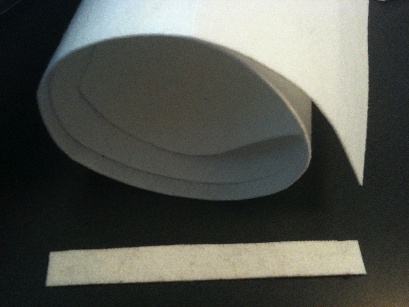
~Bra Cups: There is an entire page on Bases for Bras in which I go into detail on the four ways to get a good bra base: buy a bra with stiff cups, reinforce a regular bra, buy costuming cups, and make your own custome cups. As for the bras used in the industry, some Turkish designers make their cups out of interfacing or buckram - a material stiff like interfacing but much coarser. The down side is that the hard-angled seams are noticeable, especially in larger cup sizes. Eman Zaki has started using what look like molded silicon disks in some of their "Dina-Style" bras. Since these can't be sewn through without hurting the silicon, it looks like they sew all the beads directly onto the fabric and then glue the fabric onto the silicon cup. If you have a mold and silcon to play with you may want to try this method. I personally prefer the Fruit of the Loom bra I discuss in detail here.
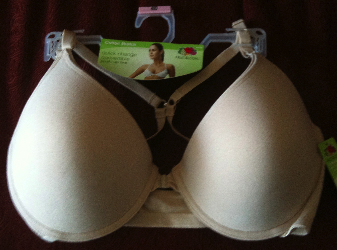
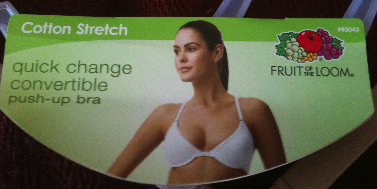
~Stretch Fabric: Fabric is made out of threads woven together. The weave affects stretch, as does the type of thread used (like lycra or elastic). Many stretch fabrics are knits, meaning that each thread loops it's way across the feild instead of going in a straight line. Some fabrics are "one way stretch", meaning they only stretch horizontally, and others are as much as "four way stretch", meaning they stretch vertically, horizontally, and on both of the diagonals. There are things you can do with stretch fabric that you can't do as easily with non-stretch fabric, such as trumpet skirts.
A very important thing you need to know about your stretch fabric is your Stretch Ratio, or in other words - how stretchy it is. If you lay your fabric flat on a table and measure a horizontal span of 10" (in the middle of the fabric, not on a cut edge) marking the boundaries with straight pins, and then stretch that same fabric to the tension you desire and it now measures 15" - for that tension your fabric has a stretch ration of 50%. I'm sure you can see how subjective this is, since everyone's desired tension could be different. Where does it come into play? When making your trumpet skirt, you'll need to make your panels narrower the higher the stretch ratio is. However, your seam allowance should always be 1/2 inch on all edges - and that is the unstretched fabric size. I break down the calculations for Stretch Ratio on the Trumpet Skirt Page.
Not all stretch fabrics are created equal. The best stretch fabrics to use are often labled as swimsuit fabrics, dance fabrics, or luxury stretch velvets. Panne (cheap crushed) velvet is incredibly difficult to work with, and other than using it to cover a bra or belt, I would advise avoiding it. (That being said, the famous Turkish designer Bella uses it all the time and makes it look fabulous by embelishing and weighing down the edges of the fabric with beading.) Fabric that's stretchy along the length of the fabric may sag along the hem of a heavier garment. There are too many types of fabric for me to give a complete break down of all of them, but to help yourself pick a good stretch fabric in the store do the following steps: stretch it horizontally across your upper legs like a mini skirt; drape it on the shelf; see if the cut edges roll a lot. If you like the way it looks stretched and draped, and the edges curl less than panne velvet, you should be fine. Pictured below, from left to right, are black panne velvet with shiny dots, silver "liquid metal" lycra, off-black mesh, and light blue cotton-poly knit.
~Non-Stretch Fabric: Most fabric available in stores are non-stretch, and to make them hug your curves they must be tailored to you very carefully. Don't let this make you write off non-stretch fabric though. A belt base isn't stretchy either, so even if you covered it in a stretch fabric, you'd still have to do all that tailoring anyway. There are absolutely beautiful brocades, chiffons, satins, and upholstery fabrics out there, waiting to become your costumes. Pictured below, from left to right, are printed satin, burgundy polyester shantung, teal polyester brocade, peach satin, and red silk shantung.
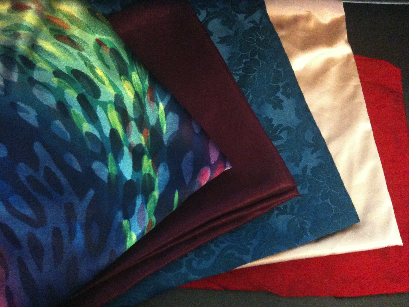
~Decorations: Beads, sequins, coins, shells, buttons, tassels, trim, feathers, jewels, ribbons, antique Indian embroidered fabrics, appliques... the list goes on. If you like it and it's smaller than a bread box, you can probably sew it onto a costume. Tribal dancers tend more towards earth tones, shells, coins, tassles, and the exotic Indian embroideries. Cabaret dancers tend more towards the beads and sequins. But keep in mind that these distinctions only exist because we think they do. It's all one bellydance, and it lies on a spectrum of aesthetic tendencies. So use what makes you happy.
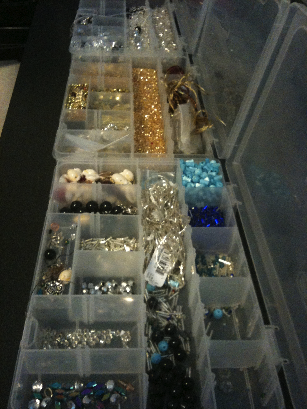
I will however break this category down more because there are so many types.
~Seed Beads: They are called seed beads because they look like little seeds. The most typical type found in fabric and craft stores are rounded seed beads, but on sparkly costumes everywhere what you'll see instead are "hex-cut" seed beads, meaning that they have six flat sides to them. This makes them sparkle a lot more. To find a good selection of hex-cut seed beads, you may have to shop online at sites like Art Beads and Fire Mountain Gems. In this photo I show both types. On the top left is a small bag of round purple seed beads, and right below it is the same color in hex-cut. By the dime are gold hex cut to the left, and gold round to the right. The bag of gold, swags of silver and small bag of silver are all hex cut. The size I usually buy is 11/0, although 8/0 (slightly larger) is also easy to find.
~Bugle Beads: These are the longer, tube like beads. They're easy to find in gold and silver in stores, but if you want a larger variety of colors you'll need to shop online. An important thing to note about bugle beads is how sharp their edges are. If they are on a strand of beads that is free to swing, they will eventually cut through the thread at the base of the fabric. To avoid this, always begin and end your strands of bugle beads with a round seed bead.
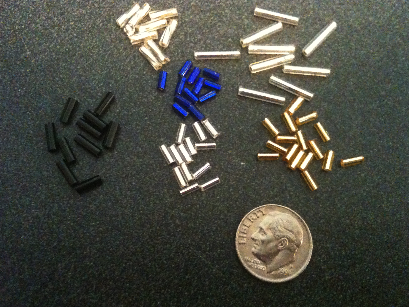
~E Beads: The beads are size E. Don't ask me what happend to D or F, but E beads are very prevalent in bellydance costuming. They look like larger versions of round seed beads, and it's very typical for cabaret costumes to be edged in a series of diagonal lines of beads made up of 4-6 seed beads and one E bead, with the E bead on the outer most edge of the garment. Like ooooO.
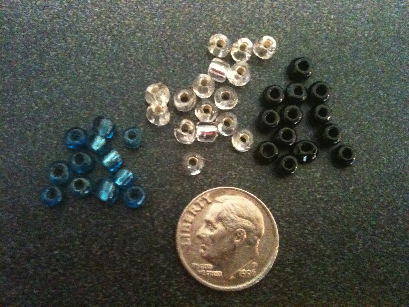
~Sequins: Sequins come in different sizes, shapes, colors, finishes, and even different concavities. In a typical fabric or craft store you can easily find silver and gold concave sequins. I used large silver concave sequins to create my Silver Lotus costume. But most designers use flat sequins, often with an irredescent quality that shows multiple colors. These types of sequins can be found online at Cartwright. Pictured below are small gold concave, large silver concave, and irredescent Tanzanite flat sequins.
